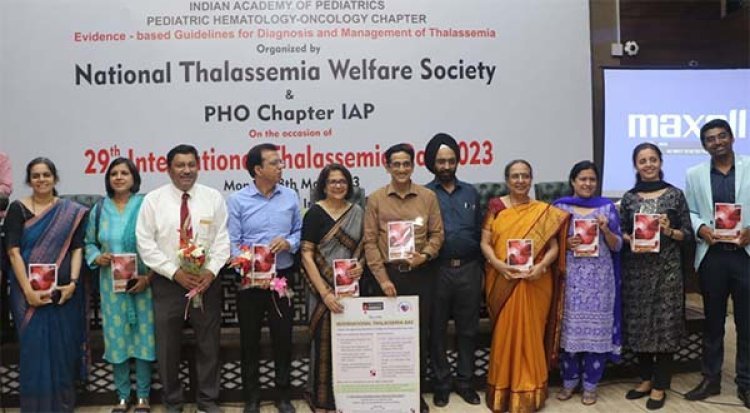National Thalassemia Welfare Society celebrated World Thalassemia Day

Integrate Thalassemia Eradication Program with Sickle Cell Anemia Elimination Mission 2047- Urged NTWS
8th May 2023 World Thalassemia Day celebrated
New Delhi, 8th May, 2023: National Thalassemia Welfare Society and Pediatric Hematology and Oncology Chapter (PHO) of Indian Academy of Pediatrics (IAP) released “Evidence-based Guidelines for Diagnosis and Management of Thalassemia”. The guidelines were released by Dr Rajiv Bahl, Secretary to Government of India, Department of Health Research and Director General, Indian Council of Medical Research.
Dr Jagdish Chandra welcomed the dignitaries and said we expect a lot from Dr Rajiv Bahl for child health programs as he himself is a pediatrician

Dr Rajiv Bahl DG ICMR said though the Sickle Cell Disease (SCD) has got more importance in recent times but thalassemia is equally important. I believe thalassemia will also get equal importance like SCD. He said all institutes of national importance and medical colleges should have stem cell transplant centres.
Thalassemia is a significant health problem in India with 3-4% carrier rate. It’s expected that around 10,000 to 12,000 new thalassemia children are born every year and around 1,50,000 thalassemia patients are dependent on regular blood transfusions for survival. Thalassemia can be prevented by creating awareness in public followed by carrier screening and prenatal diagnosis if required.
Life of a thalassemia major depends upon life-long repeated blood transfusions, iron chelating agents (drugs to remove extra iron from the body) and regular monitoring. Presently source of scientific information depends upon “International” - Thalassemia International Federation (TIF) guideline, “National” - NHM guidelines on Prevention and Control of Hemoglobinopathies in India 2016.
Situations in India are different from western countries so many recommendations of TIF cannot be implemented in our country. NHM guidelines are very brief and do not cover many aspects of management so there was need to have an exhaustive guideline for management of thalassemia which can be practiced all over India with confidence.
Dr Mamta Manglani Chairperson, Dr Nita Radhakrishnan Co-Chair and Dr Jagdish Chandra Chair, Hemoglobinopathies Subgroup of InPHOG took lead under the aegis of PHO Chapter of IAP to formulate the guidelines.
Dr Mamta Manglani said that we have come out with clear guidelines for thalassemia for primary care, early referral for managing complications, comprehensive care, long term monitoring as well as preventive care. She added that there is no national policy and no registry of thalassemia and urged the DG ICMR to roll out national registry as early as possible so that every new born with thalassemia or already under care is registered
Dr Upender Kinjwadekar president IAP said if all Govt. and private doctors follow these guidelines it will be a complete game changer
Dr Amita Trehan chairperson PHO IAP said that its unfortunate that there is enough heterogeneity in health care in our country and optimal care is not accessible to all, this results into huge burden on families and the system
Dr JS Arora general secretary of the national Thalassemia welfare society said because of lack in uniform protocol to treat thalassemia patients many patients land up into complications We hope these Evidence-based Guidelines will help the practitioners of thalassemia to provide best possible care to Thalassemia patients all over India.
Dr Nita announced that IAP along with PHO chapter has created a poster on thalassemia to be displayed at all pediatric and obs-gynae clinics. The poster was released by IAP president Dr Kinjwadekar. The poster asks obstetricians to add HbA2 report in all ante-natal cards and pediatricians to add HbA2 report in vaccination/health cards.
While thanking the Hon’ble Prime Minister of India for launching “A Mission to eliminate Sickle Cell Anemia by 2047” Dr Arora said on this International Thalassemia Day I would like to request the Hon’ble PM to integrate Thalassemia “Eradication Program along with Sickle Cell Anaemia Elimination Mission 2047”. He added prevention strategy of sickle cell disease and beta thalassemia are similar and in many parts of India they co-exist. Identifying Thalassemia along with SCA can be done without adding much burden on cost or human resources. This can be initiated at least in 17 states targeted for “Sickle Cell Anemia Elimination Mission by 2047”. After polio eradication, this is the biggest project of GOI to eliminate SCD from the country. Thalassemia should not be left behind in this mission

















